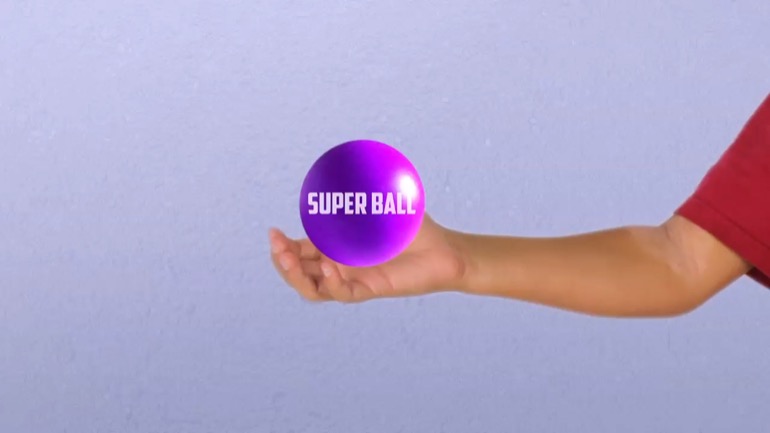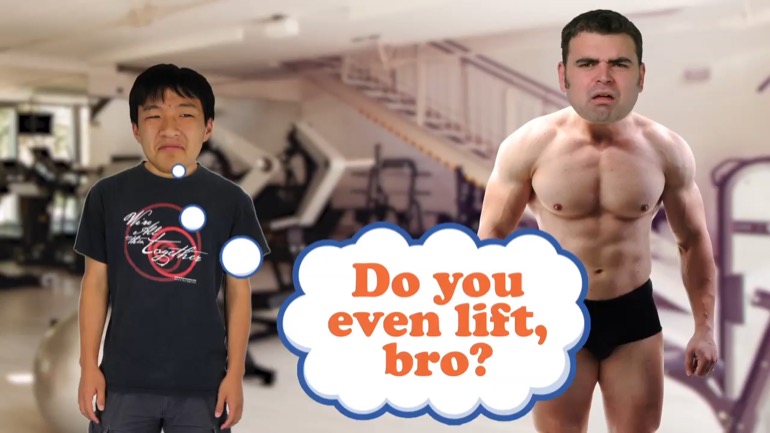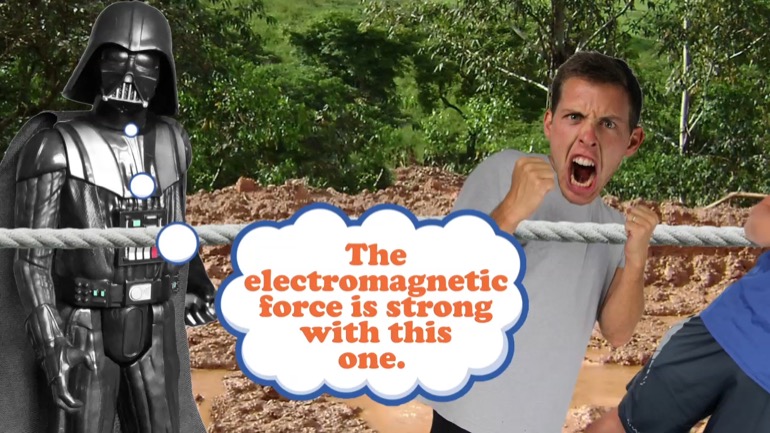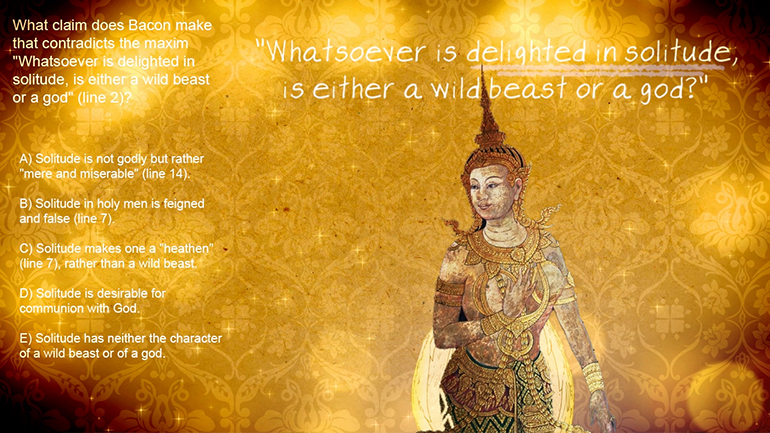ShmoopTube
Where Monty Python meets your 10th grade teacher.
Search Thousands of Shmoop Videos
Physics Videos 34 videos
Isaac Newton. Who was he? Why do we need to know about him? In a physics course, no less? Well, he's only the most famous physicist in history, and...
What are the basics of trigonometry? And why are we learning about this in a physics course? Both good questions. In this video, you'll learn about...
It's time to make our liters and meters work together. Enough of the bickering, right? In this video, we'll do some unit analysis, covering SI Unit...
Physics: Conservation of Momentum 72 Views
Share It!
Description:
The Law of Conservation of Momentum says that total momentum always stays the same in a closed system. In an open system, though, all hell usually breaks loose.
Transcript
- 00:00
Conservation of momentum. It's not just a good idea, it's the law. [mumbling]
- 00:32
All right, well it's important to have a healthy respect for the law. [cop in cop car]
- 00:36
No kneeling around here and don't seed when you drive, don't litter and don't
- 00:41
forget to tell your mom you love her. That's not a law, that's just you know being
- 00:45
nice. Alright but the truth is, there are some laws that you just can't break. Like
Full Transcript
- 00:49
it's impossible, it can't be done. Try as hard as you want, it ain't gonna happen.
- 00:52
Those are the laws of physics, not the NFL. And if you try to break one of those [two people in lab]
- 00:58
physics laws, well you won't go to physics jail, or anything. But you might
- 01:01
not be too happy with the result. Try and break the law of gravity, for example.
- 01:05
I'll just watch from a safe distance. Well one of these laws of physics, is the
- 01:11
law of conservation of momentum. This law states, that in a closed system, the total
- 01:17
amount of momentum always stays the same. Now in the real world we don't run into
- 01:21
a lot of closed systems. For example when you roll a bowling ball down the lane,
- 01:25
the bowling balls momentum is transferred to the pins, or it's [bowling ball and bowling pins]
- 01:28
transferred to the gutter. Yeah it happens. But when the ball hits the pins,
- 01:32
pins don't just bounce around forever, maintaining their momentum, that gains
- 01:35
momentum is transferred to the side walls and the lane and whatever the
- 01:39
technical term is for the back of the lane. All of those surfaces deform
- 01:44
slightly, as the momentum of the pins, is transferred. So the momentum goes to
- 01:49
these other things, within the system. But the effect is so small, we can't see it.
- 01:54
Of course, physics tends to look at ideal systems. And as we know from the fact [cop in cop car with Ferrari speeding by]
- 01:59
that we still don't have our own Ferrari, well the real world is almost never
- 02:03
ideal. But there's an equation, that expresses the conservation of momentum
- 02:07
and it's this one right here. Well this is just fancy math way of saying, that
- 02:13
the sum of all momenta, for all objects within a closed system, before the
- 02:19
objects interact, equals the sum of momentum for the objects, after they [equation on note page]
- 02:25
interact. And fortunately we can write it in a much simpler format. Yah, there
- 02:30
we go. But really it doesn't matter, because when we start doing the math, for
- 02:34
actual objects, actually interacting with each other. We replace both sides, of
- 02:39
these equation,s with the numbers for the objects. So if we just so happened, to
- 02:44
have someone, oh I don't know, sitting on a skateboard and then throwing a
- 02:48
medicine ball to someone. Well our equation would look like this. This equation says
- 02:54
that the initial momentum of the skateboarder, that's the P sub s I, plus [equation]
- 02:59
the initial momentum of the medicine ball P sub B I, equals the final momentum
- 03:05
of the skateboarder, plus the final momentum of the ball.
- 03:07
And since momentum equals mass, times velocity. We can swap those variables
- 03:12
into the equation, in place of P. So now we have this equation. Which says that,
- 03:22
the skateboarders mass, times his initial velocity, plus the ball's mass, times its
- 03:28
initial velocity, equals the skateboarders mass, times his final [formula]
- 03:33
velocity, plus the ball's mass, times its final velocity. Looking at this you can
- 03:38
see that if we have more than two objects, the equations can get a little
- 03:42
long-winded. Which is why we use that shorter
- 03:46
equation earlier. But let's go ahead and see how we would solve this equation. In
- 03:50
our scenario, we have teenagers performing physics in public. There's
- 03:54
nothing criminal in that, although it is a little weird. I've got my eye on you
- 03:57
citizens. At the start of this experiment, the skateboarder and the ball are not in [two people throwing ball to each other]
- 04:01
motion. Which means each initial velocity is a big fat zero. Let's put those values
- 04:07
into our equation. Before we go any further, we can solve the left side of
- 04:10
this thing right now. Whatever masses we're dealing with, are
- 04:12
irrelevant. Anything times zero in California, equals zero. So the initial
- 04:18
momentum of the skateboarder is zero, and the initial momentum of the medicine
- 04:20
ball zero and zero plus zero equals, seventy three billion 360. Oh wait hold
- 04:24
on, I spilled my coffee on my calculator earlier, it's on the fritz. [coffee on calculator]
- 04:27
All right zero, plus zero, is zero. Got it? So we got zilch. That's right, right hand
- 04:31
side will also have to evaluate to zero. That's only gonna happen if one of the
- 04:36
momentum on the right hand side is negative. Well remember momentum is a
- 04:40
vector quantity, so it has a magnitude and a direction.
- 04:44
Well the convention, to have any motion from left to right be a positive, value in any
- 04:48
motion from right to left be negative. Really doesn't matter though. You can set
- 04:52
whichever direction you want is positive and the other as negative. Just make sure
- 04:56
you're being consistent. The important thing to recognize here, is that we have [man throwing woman a ball while on skateboard]
- 04:59
two masses acting in opposite directions. One will have a negative velocity and
- 05:05
therefore have a negative momentum as well. So now we can set one velocity to
- 05:09
be negative in our equation, or just make the overall momentum be negative, like
- 05:13
this. And once we've done that we can see something interesting. With a bit of
- 05:18
algebra, we can add the negative momentum, to each side of our equation and find
- 05:22
that the final momentum for the skateboard, equals the final momentum for
- 05:24
the medicine ball. See how everything balances out all nice and pretty and [long equation]
- 05:29
laws of physics can be you know satisfying like that. Okay folks
- 05:34
experiment over. Let's keep moving, nothing else here to see. In that
- 05:38
skateboard experiment, we had two objects interacting and it was pretty friendly
- 05:41
interaction. But alot of times interactions between objects are gonna take the form
- 05:45
of, collisions. The collision can be a minor fender bender, or a five car pileup.[major car crash]
- 05:50
And collisions can be elastic, or inelastic. An elastic collision, occurs
- 05:57
when two objects collide and then bounce off each other going in different
- 06:02
directions. Think of playing pool. When the cue ball, hits the eight ball, the
- 06:06
balls don't just stick together, they go in different directions. Unless both
- 06:09
balls are covered in syrup, which is why waffle Wednesdays and pool tables are
- 06:14
not a good mix. An inelastic collision on the other hand, occurs when two objects
- 06:20
collide and then stick together. Say you're riding a bike, when a possum [man riding bike with possum on his back]
- 06:24
decides to hitch a ride. Well since conservation of momentum is
- 06:28
the law and you and your bike have now gained mass, in the form of a probably
- 06:33
dead marsupial. You'll therefore lose velocity. After all that's the only way
- 06:38
that momentum would stay the same, with an increase in mass. Just be careful that
- 06:43
this one looks kind of bitey, even if he is
- 06:45
potentially dead. Alright well because these problems can get confusing fast,
- 06:49
let's walk through the steps one by one, so we have a roadmap to solve them.
- 06:52
Step one, identify all the objects that interact with each other. We have two [chalk board step, and biker with possum on back]
- 06:57
objects that start off stuck together already, like the bike rider and his
- 07:01
bicycle. We can usually consider those as one object. Step two, if there are objects
- 07:07
moving in opposite directions, at any point, assign the velocity for one of the
- 07:11
directions a positive value and the velocity of the opposite direction a
- 07:15
negative value. Got that? Good. With our biker possum collision, all the velocity
- 07:21
was in the same direction. But typically we use right as the positive direction.
- 07:27
If you're feeling wild and rebellious, well go ahead and flip it around. [rebellious people]
- 07:32
Alright step three, set our balanced momentum equation. It should look
- 07:36
something like in this one. With mass and initial velocity for each object on the
- 07:40
left side and mass and final velocity for each object on the right. If we have
- 07:44
more than two objects interacting with each other, then we add the extra objects
- 07:47
to both sides of the equation, there we go.
- 07:50
Step four, if two objects stick together after a collision, we know the final
- 07:54
velocity will be the same for both objects. That means we can simplify the
- 07:58
right side of our equation, by adding up the masses of each object and [equation]
- 08:01
multiplying that sum, by the final velocity. I'll save a little work that
- 08:04
way. Alright, step 5, plug in whatever values we've been
- 08:08
provided, or have found experimentally. Since we set up our equations in advance,
- 08:13
it should be pretty straightforward. Just make sure not to mix up your masses
- 08:16
and velocities. You don't want to multiply object ones mass and object
- 08:20
twos velocity. I can't write you a ticket for that, but I can give you a [cop talking]
- 08:24
stern look. So be careful. Alright step six, remember to make the velocities
- 08:29
negative for whichever velocity direction, we've designated as our
- 08:33
negative one. If you skip this step well your right side, won't balance with your
- 08:37
left side. Which means the equation will crash and burn.
- 08:40
Step 7, solve for our unknown variable. A lot to say on this one I trust that you
- 08:45
have the requisite math skills under your belt. Alright, step eight, celebrate
- 08:50
with a doughnut. Oh sure, cops and donuts are a cliche but [cops in donut shop]
- 08:53
tell me you don't like, a nice fresh glaze and a circle of fried dough.
- 08:57
Yeah that's what I thought. Alright one last thing before we look at some problems.
- 09:01
All the motion we've looked at so far has been along one dimension. I'm not
- 09:08
sure if you've looked around lately, but life is 3d. So although we're not going
- 09:12
to deal with it right now, in the future you're likely to run across problems
- 09:15
that deal with momenta, in two, three, or if supernatural forces are involved, five
- 09:21
or six dimensions. Who knows? Which means we might have to use trigonometry to
- 09:25
break the momentum down to XY and z components. We're just telling you now so[people freaking out in classroom]
- 09:29
you don't freak out, in some of the advanced physics class later. Alright
- 09:33
well we've got your attention. Let's talk about driving safely in dangerous
- 09:36
conditions. Say we've got an icy road, three cars are driving, with car a in
- 09:40
front, driving responsibly. Car B is making sure to keep an appropriate
- 09:44
amount of space between her car and car A. Meanwhile some jerk, in car C,
- 09:49
comes barreling in. Going way over the proper speed limit for the weather. Car
- 09:54
C collides with car B and they stick together going forward, until car B hits [three vehicle car crash]
- 09:58
car A. Now all three cars are conjoined at the bumper, headed in the same
- 10:03
direction and we've got a big mess to straighten out.
- 10:05
What's the conservation of momentum equation, for this scenario and we need
- 10:10
to break it down to masses and velocities. Okay, so we know the shorthand
- 10:14
equation, the sum of momentum before interaction, equals the sum of momenta
- 10:18
after the interaction. But we could also write it like this, with P sub a P sub B
- 10:23
and P sub C. But we need to break it down to masses and velocities. So let's work on the
- 10:28
left side first. Makes sense, since it's the, you know, before side. We'll go step [equation formula]
- 10:34
by step. We know our three objects are cars A, B
- 10:37
and C. So we'll start with M sub a times, V sub AI and we'll add, M sub B, times V
- 10:42
sub B I and last but not least we got the one that started it all, M sub C
- 10:47
times V sub C I, aka jerk. All right, how about the right side. We definitely need
- 10:54
to add up the masses of each car, but since they're all sliding along this icy
- 10:58
low friction road together. We'll only have one velocity to deal with. [cars conjoined in crash]
- 11:03
So the right side of the equation will be, M sub A, plus M sub B, plus M sub C and
- 11:09
all of that will be multiplied by V sub F. Alright now we don't have any values
- 11:14
here, we're just setting up the equation. Do we have any negative momentum to deal with? Well
- 11:18
no, this wasn't a head-on collision. All the cars we're moving in the same
- 11:22
direction, so we don't need to worry about anything negative there. Here's how
- 11:26
we want our equation to be, before we plug in any values, right there. Okay,
- 11:30
let's think about another scenario. And say we've got two ice skating kangaroos. [kangaroos ice skating]
- 11:34
Which may sound crazy to you, but I've seen some things in this line of work
- 11:38
man. Yeah, I've seen some things. Anywho, well they're working on their ice
- 11:43
dancing routine and at one part of the routine they come together on the ice,
- 11:46
standing motionless, facing each other. It's really a beautiful, marsupial moment.
- 11:49
Then they push off, going in opposite directions. You can hear the music
- 11:53
crescendoing, kangaroo one has a mass of 102 kilograms,
- 11:56
slides away with the velocity of 2.1 meters a second. Kangaroo two who we're
- 12:01
gonna call kanga two. Because well it just sounds cooler, has a mass of 109 [2 kangaroos ice skating]
- 12:04
kilograms. What's kanga two's velocity as he gracefully
- 12:07
slides away? Well let's walk through this thing step by step. First we identify our
- 12:12
objects. Easy enough, we've got kanga 1 and kanga two step 2. If we have
- 12:16
motion in opposite directions, we set one is positive, the other is negative. In
- 12:20
this case kanga one's velocity has already said is positive 2.1
- 12:24
meters a second. So kanga 2 will be negative velocity and momentum. Next we
- 12:28
set up our before-and-after equation. Sum of moment of each kangaroo, before they
- 12:33
push off each other, equals the sum of momenta, after they push off each other. [kangaroo formula]
- 12:37
All right, step four says, if two objects stick together after their interaction,
- 12:42
we add up their masses and multiply that by the final velocity. But in this case
- 12:47
we have two animals that start off together, then move apart. So we can
- 12:51
add up their masses and multiply that, by the initial velocity. Okay, so now we've
- 12:56
got our equation set up. Step five says, we can start putting in the numbers. All [equation written out]
- 13:01
right on the left side, we've got one hundred two kilograms, plus hundred nine
- 13:04
kilograms and an initial velocity of nada.
- 13:07
On the right we've got a mass of 102 kilograms, times velocity of 2.1 meters a
- 13:11
second, plus a mass of 109 kilograms, times velocity were solving for. What
- 13:15
is that number? All right, right away we can see the left side is going to equal
- 13:19
zero and we can do that math on kanga one, to find a momentum of two hundred
- 13:23
fourteen point two kilogram meters per second. Then we can subtract kanga two's
- 13:28
momentum, the mass, times the unknown velocity there, from both sides of the [equation worked out]
- 13:32
equation. Leaving us with negative 109 kilograms, times V sub 2f, equaling two
- 13:38
hundred fourteen point two kilogram meters per second. And now people all we
- 13:42
have to do is, divide each side by negative 109 kilograms, to solve for the
- 13:46
missing velocity. And Kenga two's velocity equals about negative 2.0 kilogram
- 13:51
meters a second. Which makes sense kanga two has a smidge more mass, than kanga one
- 13:56
so his velocity should be a smidge less. Truth is you can break most laws. I might [cop in cop car]
- 14:02
not see you speed on the highway and if you're super careful, jaywalking isn't
- 14:06
gonna be a big deal most of the time. And your mom might say you get away with
- 14:09
murder, but that's just a figure of speech. Please don't take her literally.
- 14:13
But yeah you're not breaking the law of conservation of momentum. Don't even
- 14:16
bother trying. All right if the Isaac Newton and Rene Descartes
- 14:20
say it's law, well you better take their word for it. [court room with people in it]
Related Videos
When you're about to marry the love of your life, not many things could stop you. However, finding out that your future hubby is keeping his crazy...
Here at Shmoop, we work for kids, not just the bottom line. Founded by David Siminoff and his wife Ellen Siminoff, Shmoop was originally conceived...
ACT Math: Elementary Algebra Drill 4, Problem 5. What is the solution to the problem shown?
AP® English Literature and Composition Passage Drill 1, Problem 1. Which literary device is used in lines 31 to 37?
AP® English Literature and Composition Passage Drill 2, Problem 1. What claim does Bacon make that contradicts the maxim "Whatsoever is delig...






































